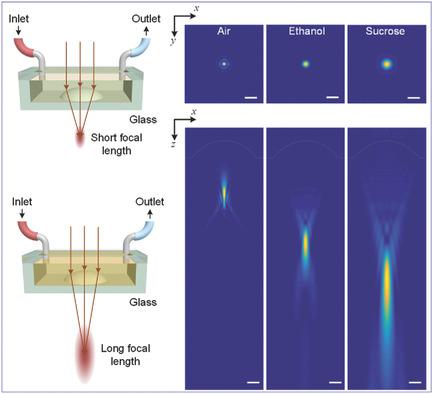当前位置:
X-MOL 学术
›
Adv. Opt. Mater.
›
论文详情
Our official English website, www.x-mol.net, welcomes your
feedback! (Note: you will need to create a separate account there.)
All‐Glass 3D Optofluidic Microchip with Built‐in Tunable Microlens Fabricated by Femtosecond Laser‐Assisted Etching
Advanced Optical Materials ( IF 8.0 ) Pub Date : 2018-02-28 , DOI: 10.1002/adom.201701299 Yanlei Hu 1 , Shenglong Rao 1 , Sizhu Wu 2 , Pengfei Wei 3 , Weixin Qiu 1 , Dong Wu 1 , Bing Xu 1 , Jincheng Ni 1 , Liang Yang 1 , Jiawen Li 1 , Jiaru Chu 1 , Koji Sugioka 4
Advanced Optical Materials ( IF 8.0 ) Pub Date : 2018-02-28 , DOI: 10.1002/adom.201701299 Yanlei Hu 1 , Shenglong Rao 1 , Sizhu Wu 2 , Pengfei Wei 3 , Weixin Qiu 1 , Dong Wu 1 , Bing Xu 1 , Jincheng Ni 1 , Liang Yang 1 , Jiawen Li 1 , Jiaru Chu 1 , Koji Sugioka 4
Affiliation

|
Development of tunable microlenses by taking advantage of the physical adaptability of fluids is one of the challenges of optofluidic techniques, since it offers many applications in biochips, consumer electronics, and medical engineering. Current optofluidic tuning methods using electrowetting or pneumatic pressure typically suffer from high complexity involving external electromechanical actuating devices and limited tuning performance. In this paper, a novel and simple tuning method is proposed that changes the liquid refractive index in an optofluidic channel while leaving the shape of the microlens unchanged. To create an optofluidic microlens with high robustness and optical performance, built‐in microlenses are fabricated inside 3D glass microfluidic channels by optimized single‐operation wet etching assisted by a femtosecond laser. Tuning of focusing properties is demonstrated by filling the channel with media having different indices. Continuous tuning over a wide range (more than threefold tunability for both focal length and focal spot size) is also achieved by pumping sucrose solutions with different concentrations into the microchip channels. Reversible tuning is experimentally verified, indicating intriguing properties of the all‐glass optofluidic microchip. Both the proposed tuning method and the all‐glass architecture with built‐in microlens offer great potential toward numerous applications, including microfluidic adaptive imaging and biomedical sensing.
中文翻译:

具有飞秒激光辅助刻蚀的内置可调谐微透镜的全玻璃3D光电芯片
利用流体的物理适应性来开发可调谐微透镜是光流技术的挑战之一,因为它在生物芯片,消费电子和医学工程中提供了许多应用。当前使用电润湿或气压的光流体调节方法通常会遭受涉及外部机电致动装置的高复杂度和有限的调节性能的困扰。在本文中,提出了一种新颖且简单的调整方法,该方法可以在保持微透镜形状不变的情况下改变光流通道中的液体折射率。为了创建具有高鲁棒性和光学性能的光流体微透镜,内置的微透镜是通过飞秒激光辅助的优化的单次操作湿法刻蚀在3D玻璃微流体通道内制造的。通过用具有不同索引的介质填充通道来演示聚焦特性的调整。通过将不同浓度的蔗糖溶液泵入微芯片通道,还可以在宽范围内进行连续调谐(焦距和焦斑尺寸的可调性都超过三倍)。可逆调谐已通过实验验证,表明全玻璃光流微芯片具有吸引人的特性。所提出的调谐方法和带有内置微透镜的全玻璃架构都为许多应用提供了巨大的潜力,包括微流体自适应成像和生物医学传感。通过将不同浓度的蔗糖溶液泵入微芯片通道,还可以在宽范围内进行连续调谐(焦距和焦斑尺寸的可调性都超过三倍)。可逆调谐已通过实验验证,表明全玻璃光流微芯片具有吸引人的特性。所提出的调谐方法和带有内置微透镜的全玻璃架构都为许多应用提供了巨大的潜力,包括微流体自适应成像和生物医学传感。通过将不同浓度的蔗糖溶液泵入微芯片通道,还可以在宽范围内进行连续调谐(焦距和焦斑尺寸的可调性都超过三倍)。可逆调谐已通过实验验证,表明全玻璃光流微芯片具有吸引人的特性。所提出的调谐方法和带有内置微透镜的全玻璃架构都为许多应用提供了巨大的潜力,包括微流体自适应成像和生物医学传感。
更新日期:2018-02-28
中文翻译:

具有飞秒激光辅助刻蚀的内置可调谐微透镜的全玻璃3D光电芯片
利用流体的物理适应性来开发可调谐微透镜是光流技术的挑战之一,因为它在生物芯片,消费电子和医学工程中提供了许多应用。当前使用电润湿或气压的光流体调节方法通常会遭受涉及外部机电致动装置的高复杂度和有限的调节性能的困扰。在本文中,提出了一种新颖且简单的调整方法,该方法可以在保持微透镜形状不变的情况下改变光流通道中的液体折射率。为了创建具有高鲁棒性和光学性能的光流体微透镜,内置的微透镜是通过飞秒激光辅助的优化的单次操作湿法刻蚀在3D玻璃微流体通道内制造的。通过用具有不同索引的介质填充通道来演示聚焦特性的调整。通过将不同浓度的蔗糖溶液泵入微芯片通道,还可以在宽范围内进行连续调谐(焦距和焦斑尺寸的可调性都超过三倍)。可逆调谐已通过实验验证,表明全玻璃光流微芯片具有吸引人的特性。所提出的调谐方法和带有内置微透镜的全玻璃架构都为许多应用提供了巨大的潜力,包括微流体自适应成像和生物医学传感。通过将不同浓度的蔗糖溶液泵入微芯片通道,还可以在宽范围内进行连续调谐(焦距和焦斑尺寸的可调性都超过三倍)。可逆调谐已通过实验验证,表明全玻璃光流微芯片具有吸引人的特性。所提出的调谐方法和带有内置微透镜的全玻璃架构都为许多应用提供了巨大的潜力,包括微流体自适应成像和生物医学传感。通过将不同浓度的蔗糖溶液泵入微芯片通道,还可以在宽范围内进行连续调谐(焦距和焦斑尺寸的可调性都超过三倍)。可逆调谐已通过实验验证,表明全玻璃光流微芯片具有吸引人的特性。所提出的调谐方法和带有内置微透镜的全玻璃架构都为许多应用提供了巨大的潜力,包括微流体自适应成像和生物医学传感。











































 京公网安备 11010802027423号
京公网安备 11010802027423号